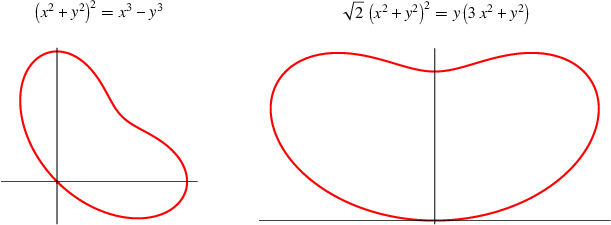There are a few plane curves known as "bean curves."
The bean curve identified by Cundy and Rowllet (1989, p. 72) is the quartic curve given by the implicit equation
|
(1)
|
It has horizontal tangents at and vertical tangents at
and
. The area enclosed by the curve is given by
|
(2)
| |||
|
(3)
| |||
|
(4)
|
(OEIS A193505). The geometric centroid
of the interior by
|
(5)
| |||
|
(6)
|
and the area moment of inertia tensor of the interior by
|
(7)
| |||
|
(8)
| |||
|
(9)
|
(E. Weisstein, Feb. 3-5, 2018). The perimeter is given by
 |
(10)
| ||
|
(11)
|
(OEIS A193506).

A second bean curve that more closely resembles an actual bean (in particular, a lima bean), here called the "lima bean curve," is given by the simple polar equation
|
(12)
|
(Wassenaar; left figure above). It also is a quartic curve and has Cartesian equation
|
(13)
|
If the lima bean is rotated so that it appears entirely in the half-plane and is oriented symmetrically about the
-axis (right figure above), its Cartesian
equation becomes
|
(14)
|
The parametric equations of the original polar curve are
|
(15)
| |||
|
(16)
|
This curve has maximum values and minimum values
, where
is the real root of
. The area enclosed by the curve is
|
(17)
| |||
|
(18)
|
(cf. OEIS A244978). The geometric centroid
of the interior is given by
|
(19)
| |||
|
(20)
|
and the perimeter by
|
(21)
| |||
|
(22)
| |||
 |
(23)
| ||
|
(24)
|
(OEIS A336501). The area moment of inertia tensor of the interior is given by
![I=[(123pi)/(2048)a^4 -(9pi)/(1024)a^4; -(9pi)/(1024)a^4 (123pi)/(2048)a^4].](/images/equations/BeanCurve/NumberedEquation5.svg) |
(25)
|